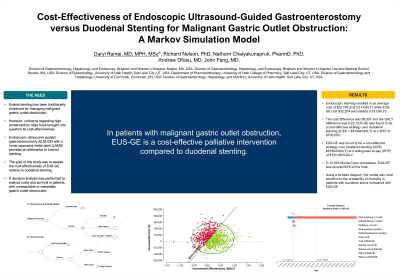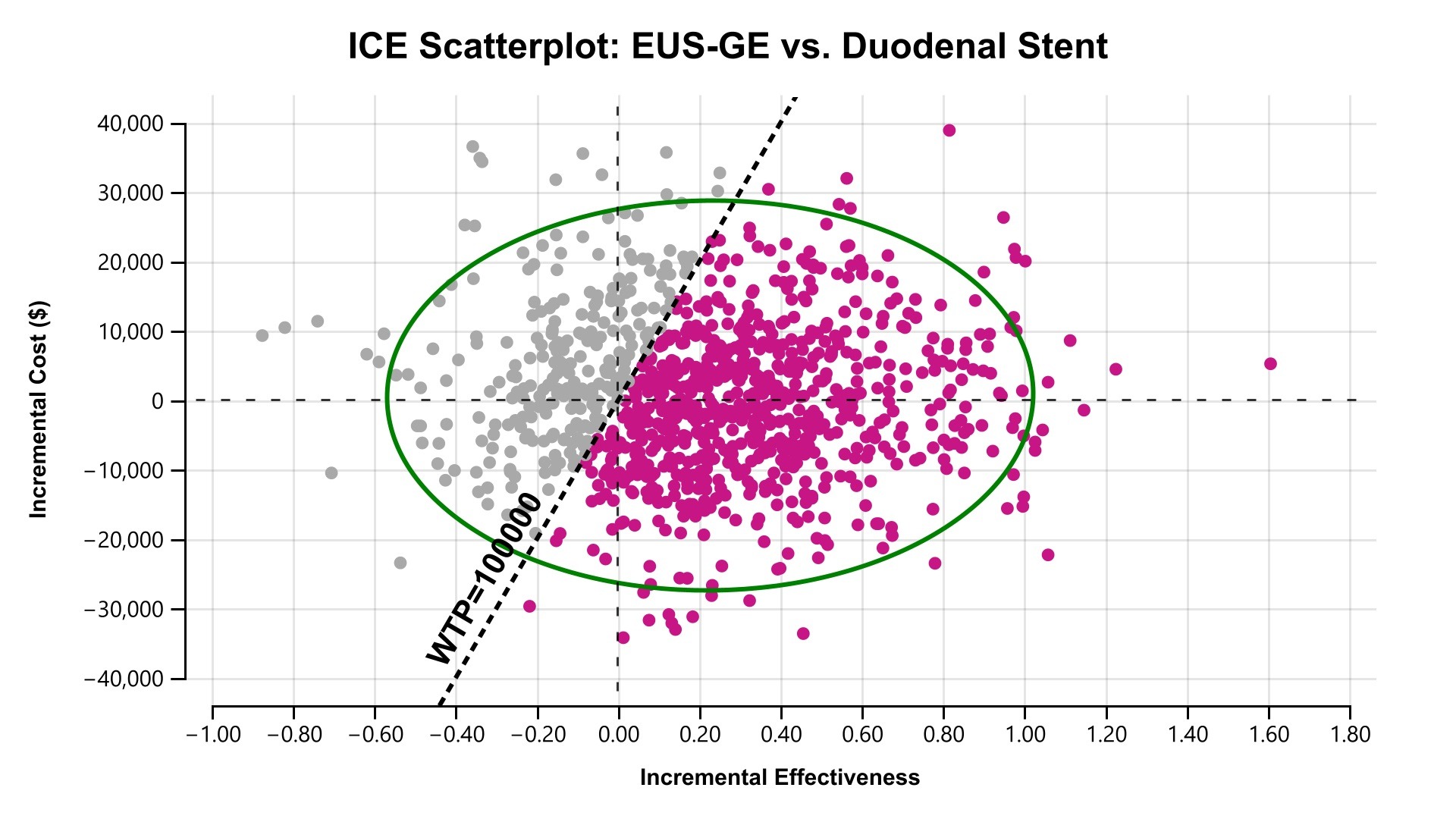Monday Poster Session
Category: Interventional Endoscopy
P2752 - Cost-Effectiveness of Endoscopic Ultrasound-Guided Gastroenterostomy versus Duodenal Stenting for Malignant Gastric Outlet Obstruction: A Markov Simulation Model
Monday, October 28, 2024
10:30 AM - 4:00 PM ET
Location: Exhibit Hall E


Daryl Ramai, MD, MPH, Msc
University of Utah Health
Salt Lake City, UT
Presenting Author(s)
Daryl Ramai, MD, MPH, Msc1, Richard Nelson, PhD2, Nathorn Chaiyakunapruk, PhD2, John Fang, MD2
1University of Utah Health, Salt Lake City, UT; 2University of Utah, Salt Lake City, UT
Introduction: Enteral stenting has been traditionally employed for managing malignant gastric outlet obstruction. However, concerns regarding high reintervention rates have brought into question its cost-effectiveness. Endoscopic ultrasound–guided gastroenterostomy (EUS-GE) with a lumen-apposing metal stent (LAMS) provides an alternative to luminal stenting. The goal of this study was to assess the cost-effectiveness of EUS-GE relative to duodenal stenting.
Methods: A decision analysis was performed to analyze costs and survival in patients with unresectable or metastatic gastric outlet obstruction. The model was designed with two treatment arms: self-expanding metal stent (SEMS) placement and EUS-GE with LAMS. Costs were derived from Medicare reimbursement rates (US$) while effectiveness was measured by quality-adjusted life years (QALYs). The primary outcome measure was the incremental cost-effectiveness ratio (ICER). Probabilistic sensitivity analyses were performed.
Results: Endoscopic stenting resulted in an average cost of $15,604 and 0.31 QALYs while EUS-GE cost $16,637 and yielded 0.55 QALYs. The yielded a $1,033 cost difference and QALY 0.24. EUS-GE was found to be a cost-effective strategy over duodenal stenting (ICER, $4394/QALY) at a willingness-to-pay (WTP) of $100,000/QALY. In 10,000 Monte-Carlo simulations, EUS-GE was favored 74% of the time. Using a tornado diagram, the model was most sensitive to the probability of mortality in patients with duodenal stents compared with EUS-GE.
Discussion: In patients with malignant gastric outlet obstruction, EUS-GE is a cost-effective palliative intervention compared to duodenal stenting. Further studies should focus on barriers to adopting this therapeutic approach across different clinical practices.

Disclosures:
Daryl Ramai, MD, MPH, Msc1, Richard Nelson, PhD2, Nathorn Chaiyakunapruk, PhD2, John Fang, MD2. P2752 - Cost-Effectiveness of Endoscopic Ultrasound-Guided Gastroenterostomy versus Duodenal Stenting for Malignant Gastric Outlet Obstruction: A Markov Simulation Model, ACG 2024 Annual Scientific Meeting Abstracts. Philadelphia, PA: American College of Gastroenterology.
1University of Utah Health, Salt Lake City, UT; 2University of Utah, Salt Lake City, UT
Introduction: Enteral stenting has been traditionally employed for managing malignant gastric outlet obstruction. However, concerns regarding high reintervention rates have brought into question its cost-effectiveness. Endoscopic ultrasound–guided gastroenterostomy (EUS-GE) with a lumen-apposing metal stent (LAMS) provides an alternative to luminal stenting. The goal of this study was to assess the cost-effectiveness of EUS-GE relative to duodenal stenting.
Methods: A decision analysis was performed to analyze costs and survival in patients with unresectable or metastatic gastric outlet obstruction. The model was designed with two treatment arms: self-expanding metal stent (SEMS) placement and EUS-GE with LAMS. Costs were derived from Medicare reimbursement rates (US$) while effectiveness was measured by quality-adjusted life years (QALYs). The primary outcome measure was the incremental cost-effectiveness ratio (ICER). Probabilistic sensitivity analyses were performed.
Results: Endoscopic stenting resulted in an average cost of $15,604 and 0.31 QALYs while EUS-GE cost $16,637 and yielded 0.55 QALYs. The yielded a $1,033 cost difference and QALY 0.24. EUS-GE was found to be a cost-effective strategy over duodenal stenting (ICER, $4394/QALY) at a willingness-to-pay (WTP) of $100,000/QALY. In 10,000 Monte-Carlo simulations, EUS-GE was favored 74% of the time. Using a tornado diagram, the model was most sensitive to the probability of mortality in patients with duodenal stents compared with EUS-GE.
Discussion: In patients with malignant gastric outlet obstruction, EUS-GE is a cost-effective palliative intervention compared to duodenal stenting. Further studies should focus on barriers to adopting this therapeutic approach across different clinical practices.

Figure: Scatter plot of probabilistic sensitivity analysis. The incremental cost-effectiveness scatter plot for each of the 2 studied treatment strategies showing the iterations occurring either above (duodenal stenting) or below (EUS-GE) the willingness-to-pay (WTP) threshold of $100,000/quality-adjusted life-year (QALY), with the oval showing the 95% CI. This visually represents what was found in the cost-effectiveness acceptability curve.
Disclosures:
Daryl Ramai indicated no relevant financial relationships.
Richard Nelson indicated no relevant financial relationships.
Nathorn Chaiyakunapruk indicated no relevant financial relationships.
John Fang indicated no relevant financial relationships.
Daryl Ramai, MD, MPH, Msc1, Richard Nelson, PhD2, Nathorn Chaiyakunapruk, PhD2, John Fang, MD2. P2752 - Cost-Effectiveness of Endoscopic Ultrasound-Guided Gastroenterostomy versus Duodenal Stenting for Malignant Gastric Outlet Obstruction: A Markov Simulation Model, ACG 2024 Annual Scientific Meeting Abstracts. Philadelphia, PA: American College of Gastroenterology.
